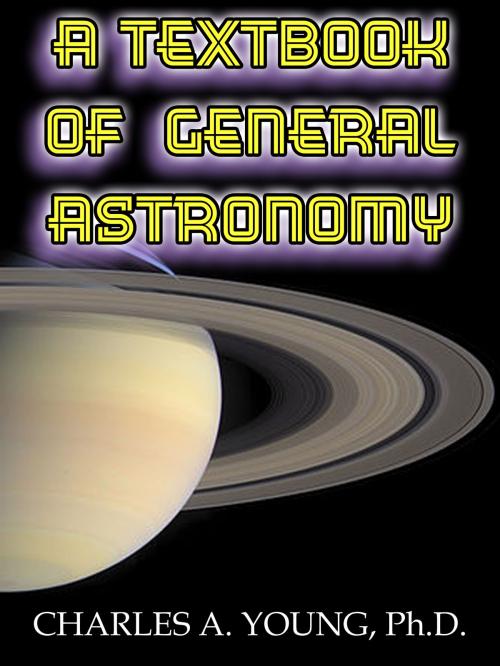A Textbook of General Astronomy
Nonfiction, Science & Nature, Science, Physics, Cosmology, Astronomy, Astrophysics & Space Science| Author: | Charles A. Young, Ph. D. | ISBN: | 1230000128948 |
| Publisher: | Young | Publication: | May 1, 2013 |
| Imprint: | Language: | English |
| Author: | Charles A. Young, Ph. D. |
| ISBN: | 1230000128948 |
| Publisher: | Young |
| Publication: | May 1, 2013 |
| Imprint: | |
| Language: | English |
1. Astronomy is the science which treats of the heavenly bodies. As such bodies we reckon the sun and moon, the planets (of which the earth is one) and their satellites, comets and meteors, and finally the stars and nebulae.
We have to consider in Astronomy:
(a) The motions of these bodies, both real and apparent, and the laws which govern these motions.
(b) Their forms, dimensions, and masses.
(c) Their nature and constitution.
(d) The effects they produce upon each other by their attractions, radiations, or by any other ascertainable influence.
It was an early, and has been a most persistent, belief that the heavenly bodies have a powerful influence upon human affairs, so that from a knowledge of their positions and \aspects" at critical moments (as for instance at the time of a person's birth) one could draw up a \horoscope" which would indicate the probable future. The pseudo-science which was founded on this belief was named Astrology, the elder sister of Alchemy and for centuries Astronomy was its handmaid; i.e., astronomical observations and calculations were made mainly in order to supply astrological data.
2. Astronomy is divided into many branches, some of which, as ordinarily recognized, are the following:
a. Descriptive Astronomy - This, as its name implies, is merely an orderly statement of astronomical facts and principles.
b. Practical Astronomy - This is quite as much an art as a science, and treats of the instruments, the methods of observation, and the processes of calculation by which astronomical facts are ascertained.
c. Theoretical Astronomy, which treats of the calculations of orbits and ephemerides, including the effects of so-called perturbations."
d. Mechanical Astronomy, which is simply the application
of mechanical principles to explain astronomical facts (chiefly the planetary and lunar motions). It is sometimes called Gravitational Astronomy, because, with few exceptions, gravitation is the only force sensibly concerned in the motions of the heavenly bodies. Until within thirty years this branch of the science was generally designated as Physical Astronomy, but the term is now objectionable because of late it has been used by many writers to denote a very different and comparatively new branch of the science.
e. Astronomical Physics, or Astro-physics -This treats of the physical characteristics of the heavenly bodies, their brightness and spectroscopic peculiarities, their temperature and radiation, the nature and condition of their atmospheres and surfaces, and all phenomena which indicate or depend on their physical condition.
f. Spherical Astronomy -This, discarding all consideration of absolute dimensions and distances, treats the heavenly bodies simply as objects moving on the \surface of the celestial sphere": it has to do only with angles and directions, and, strictly regarded, is in fact merely Spherical Trigonometry applied to Astronomy.
3. The above-named branches are not distinct and separate, but they overlap in all directions. Spherical Astronomy, for instance, finds the demonstration of many of its formula in Gravitational Astronomy, and their application appears in Theoretical and Practical Astronomy. But valuable works exist bearing all the different titles indicated above, and it is important for the student to know what subjects he may expect to find discussed in each; for this reason it has seemed worthwhile to name and define the several branches, although they do not distribute the science between them in any strictly logical and mutually exclusive manner. In the present text-book little regard will be paid to these subdivisions, since the object of the work is not to present a complete
and profound discussion of the subject such as would be demanded by a professional astronomer, but only to give so much knowledge of the facts and such an understanding of the principles of the science as may fairly be considered essential to a liberal education.
1. Astronomy is the science which treats of the heavenly bodies. As such bodies we reckon the sun and moon, the planets (of which the earth is one) and their satellites, comets and meteors, and finally the stars and nebulae.
We have to consider in Astronomy:
(a) The motions of these bodies, both real and apparent, and the laws which govern these motions.
(b) Their forms, dimensions, and masses.
(c) Their nature and constitution.
(d) The effects they produce upon each other by their attractions, radiations, or by any other ascertainable influence.
It was an early, and has been a most persistent, belief that the heavenly bodies have a powerful influence upon human affairs, so that from a knowledge of their positions and \aspects" at critical moments (as for instance at the time of a person's birth) one could draw up a \horoscope" which would indicate the probable future. The pseudo-science which was founded on this belief was named Astrology, the elder sister of Alchemy and for centuries Astronomy was its handmaid; i.e., astronomical observations and calculations were made mainly in order to supply astrological data.
2. Astronomy is divided into many branches, some of which, as ordinarily recognized, are the following:
a. Descriptive Astronomy - This, as its name implies, is merely an orderly statement of astronomical facts and principles.
b. Practical Astronomy - This is quite as much an art as a science, and treats of the instruments, the methods of observation, and the processes of calculation by which astronomical facts are ascertained.
c. Theoretical Astronomy, which treats of the calculations of orbits and ephemerides, including the effects of so-called perturbations."
d. Mechanical Astronomy, which is simply the application
of mechanical principles to explain astronomical facts (chiefly the planetary and lunar motions). It is sometimes called Gravitational Astronomy, because, with few exceptions, gravitation is the only force sensibly concerned in the motions of the heavenly bodies. Until within thirty years this branch of the science was generally designated as Physical Astronomy, but the term is now objectionable because of late it has been used by many writers to denote a very different and comparatively new branch of the science.
e. Astronomical Physics, or Astro-physics -This treats of the physical characteristics of the heavenly bodies, their brightness and spectroscopic peculiarities, their temperature and radiation, the nature and condition of their atmospheres and surfaces, and all phenomena which indicate or depend on their physical condition.
f. Spherical Astronomy -This, discarding all consideration of absolute dimensions and distances, treats the heavenly bodies simply as objects moving on the \surface of the celestial sphere": it has to do only with angles and directions, and, strictly regarded, is in fact merely Spherical Trigonometry applied to Astronomy.
3. The above-named branches are not distinct and separate, but they overlap in all directions. Spherical Astronomy, for instance, finds the demonstration of many of its formula in Gravitational Astronomy, and their application appears in Theoretical and Practical Astronomy. But valuable works exist bearing all the different titles indicated above, and it is important for the student to know what subjects he may expect to find discussed in each; for this reason it has seemed worthwhile to name and define the several branches, although they do not distribute the science between them in any strictly logical and mutually exclusive manner. In the present text-book little regard will be paid to these subdivisions, since the object of the work is not to present a complete
and profound discussion of the subject such as would be demanded by a professional astronomer, but only to give so much knowledge of the facts and such an understanding of the principles of the science as may fairly be considered essential to a liberal education.















